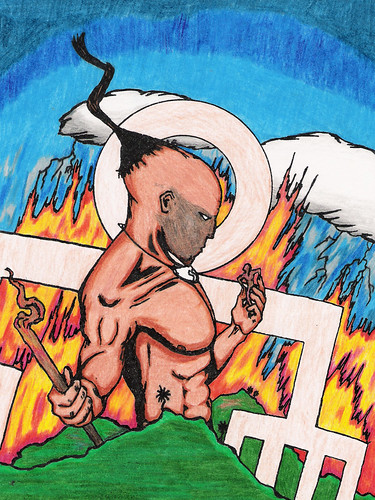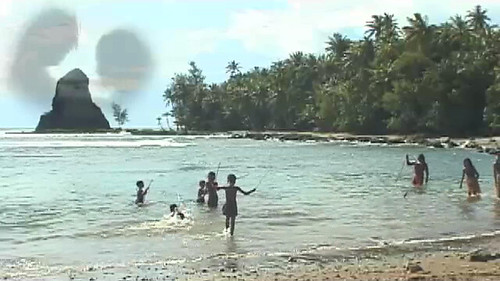Animism
Ancient religious philosophy
Animism is the belief that everything in nature – living and non-living – contains a spirit or soul. In ancient CHamoru/Chamorro society, the CHamorus held animism as a religious philosophy that supported the concept of the interconnectedness between people and nature. All native cultures practice some aspect of animism.
The practice of animism
In the Marianas, animism is manifested through the ancient CHamoru creation myth of a celestial brother and sister – Puntan and Fu’una – who created the universe and people. Puntan asked his sister, Fu’una, to help him create the universe with parts of his body. When she completed the tasks, she fell to the newly created earth at Fouha Bay near the southern Guam village of Humåtak and turned into a monolithic rock formation where the first people of the earth came from.
There is historical documentation of this story including from Catholic priest Diego Luis de San Vitores whose evangelical efforts in the latter half of the 17th century yielded a contemporary predominantly Catholic congregation on Guam and her neighboring Mariana Islands. San Vitores recorded the pilgrimage of ancient CHamorus to the site – Fouha Bay – where CHamorus believe human life originated. Renown anthropologist Laura Thompson noted that:
Elsewhere Sanvitores… stated, ‘Fuuna [a point on the coast of southwest Guam] is celebrated among these natives for there is in it a rock, or stone, from which they believe all men had their origin…’ This is apparently an explanatory element in the same creation myth.
The CHamoru legend of Chaife, an evil underworld lord, brought in elements of animism to explain natural phenomena such as tidal waves and typhoons as Chaife tried to destroy a soul which he mistakenly believed escaped during his creation of it.
Animism is further exemplified in the CHamoru people’s reverence of the tronkon nunu (banyan tree) believed to be the dwelling place of taotaomo’na that CHamorus believe were “the people of before; the ancestral spirits that inhabited the earth along with the living.” Many CHamorus still avoid going near banyan trees. At the University of Guam, and other local government facilities, structures were built around the trees to protect them. Thompson also wrote:
In modern Guam the abode of the ancestors is believed to be the banyan tree. Safford… wrote, ‘Don Jose told me that on a spot where we were standing there used to grow a great nunu (banyan tree). It was thought to be a resort for manganiti (plural of anite)…, and people were afraid to pass by, especially after nightfall.’ This belief appears to be a survival from ancient times.
…The beings, which inhabit the banyan tree, are often called bihu (elders) today, and the bark of the banyan is used by some herb doctors to cure illness, especially that believed to be caused by supernatural agents.
Modern animistic residual
Further examples of how semblances of the ancient practice of animism has prevailed throughout the centuries is shown when a person of CHamoru descent – or those who have lived in Guam or the Mariana Islands – will ask for permission in the form of a chant before entering the hålomtåno’ (jungle) or relieving themselves in the jungle. It is believed that the taotaomo’na that inhabit the space will cause them harm or make them fall ill if they do not show the proper respect for the land.
Even in present-day Guam, despite the prevalence of the Catholic and other Western religions in addition to the availability of modern medical assistance, if a person falls mysteriously ill, and it is possibly the result of angering or offending the taotaomo’na, they seek the help of a suruhånu, a CHamoru medical healer, to help cure their ailments. CHamorus believe they must return to the site where they the offense occurred and ask for forgiveness of the infraction before they can be healed.
For further reading
Cunningham, Lawrence J. Ancient Chamorro Society. Honolulu: Bess Press, 1992.
Freycinet, Louis Claude Desaulses de. An Account of the Corvette L’Uraine’s Sojourn at the Mariana Islands, 1819. Translated by Glynn Barratt. Saipan: Commonwealth of the Northern Mariana Islands Division of Historic Preservation, 2003.
McMakin, Patrick D. “The Suruhanos: Traditional Curers on the Island of Guam.” Micronesica 14, no. 1 (1978): 13-67.
Mitchell, Roger E. “Ancestral Spirits and Hitchhiking Ghosts: Syncretism on Guam.” Midwestern Journal of Language and Folklore 2, no. 2 (1976): 45-55.
Thompson, Laura M. The Native Cultures of the Mariana Islands. Bernice P. Bishop Museum Bulletin 185. Honolulu: Bishop Museum Press, 1945.



